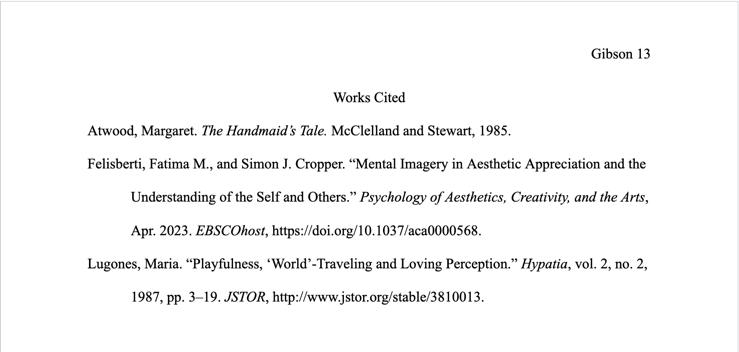The Modern Language Association (MLA) is a citation and style guide typically used in the humanities. This handout explains how to format and cite work according to the MLA 9 th edition handbook (section numbers listed in headings). This resource provides general information about MLA format and style, but writers should always tailor their work to their audience and assignment guidelines.

The heading includes the following, each on its own line: Your name(s), instructor’s name, course, and date. The heading starts on the first page’s first line, not in the header above the first line. For group papers, each author is given their own line in the heading. The title should be centered and in title case with no special formatting (no boldface, italics, quotation marks, or underline) unless it contains a book or other large work.
Place visual elements as close to the related text as possible. Double-space tables, labels, and captions.
Label with “Table #” and a title; both should be left-aligned on separate lines above the table. If adapting data from a source’s table into a new table, place its source and notes in a caption below the table. To cite information from a table in-text, include the table number in square brackets after the page number.
Example: Table 1
Distribution of Literature Degrees in the U.S., 2014–2016
| Year | Bachelor’s Degrees | Master’s Degrees | Doctoral Degrees |
|---|---|---|---|
| 2004–05 | 16,008 | 2,517 | 762 |
| 2005–06 | 16,762 | 2,637 | 778 |
Adapted from: U.S. Department of Education, Institute of Education Sciences,
National Center for Education Statistics. Digest of Education Statistics, 2017 ed.,
June 2017, table 297, nces.ed.gov/programs/digest/d07/tables/dt07_297.asp.
Example (In-text Citation): (U.S Department of Education 14 [table 1])
Other types of visual material, such as photographs, maps, graphs, or charts, should be labeled “Figure #” (usually abbreviated Fig.) and include an identifying caption below. If a writer chooses to give a full citation in the caption and does not cite it elsewhere, no entry is needed in the works cited.
Example (Full Citation):

Fig. 2 James Modarelli, NASA Insignia. 1959, National Aeronautics and Space Administration. www.nasa.gov/symbols-of-nasa.html.
Example (Partial Citation):

Fig. 2 James Modarelli, NASA Insignia
Quotes longer than four lines are set apart in a block, double-spaced, and indented .5 inch from the margin. No quotation marks are necessary. The period is placed after the quotation, unlike in-text citation which places it after the citation. Your work should primarily reflect your own words and ideas, so avoid overusing block quotes, as they can distract the reader and detract from your own voice.
In-text citations refer readers to sources and must be used for direct quotes, summaries, and paraphrases. There are two kinds of in-text citation: parenthetical and in prose. Parenthetical puts the author’s last name and the page number at the end of the sentence. A citation in prose names the author in the sentence itself. When available, page number(s) are included for both styles.
| Citation In Prose | Parenthetical Citation | Notes | |
|---|---|---|---|
| Two Authors (6.5) | Dorris and Erdrich argue that. . . (23). | (Dorris and Erdrich 23). | Use the same order of names as the source. |
| Three or More Authors (6.5)Three or More Authors (6.5) | Burdick and others analyze | (Burdick et al. 42). | et al. is Latin for “and others” |
| Organization as Author (6.6) | The National Academy found. . . (114). | (National Academy 114). | Capitalize the organization name. No additional formatting is required. |
| Same Author, Multiple Works (6.8) | In her book Jazz, Morrison says, “. . .” (76). | (Morrison, Jazz 76). | Add a comma after the author’s name(s), then add the title. |
| Authors with Same Last Name (6.7) | J. Rogers opens with, “. . .” (654). | (J. Rogers 654).(Jack Rogers 654). | Include the author’s first initial. If the initial is the same, include the entire first name. |
| Multiple Sources in One Sentence (6.46) | Avoid in prose in this case, it could look like multiple authors for one text. | (Burdick et al. 42; Rogers 7). | Separate each source with a semicolon. |
| Indirect Quotation* (6.50) *A quote within a quote |
Lang uses Grant’s theory to support her claim, “. . .” (129). | “. . . ‘. . .’ . . .” (qtd. in Lang 129). Use single quotation marks when quotation marks appear in the source. | Whenever possible, use material from the original source and not a secondary source. |
| Quoting Poetry (6.22, 6.37) | The last lines of Williams’ poem are “so sweet / and so cold” | The lines “so sweet / and so cold” (Williams’ lines 11–12). | A slash indicates a line break. Stanza breaks, use two slashes (//). |
The works cited page is a separate page included at the end of the paper. The words “Works Cited” should be centered at the top of the page. Entries should be in alphabetical order, set in a hanging indent, and double-spaced. Use a full citation for every source so readers may investigate them for further reading. Each citation is made up of core elements.

Core elements are used to create each citation. The core elements of a citation are as follows:
When punctuating a citation, use a period after author, title of source, supplemental elements, and at the end of a citation. Separate all other elements with a comma. Core elements should appear in a citation in the order previously listed.
If a core element does not apply to the source being cited, omit it—unless the source does not have a title, in which case, you will provide a brief description of the source. For sources with no author or organization name, begin the citation with the title.